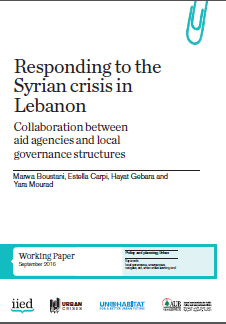Responding to the Syrian crisis in Lebanon Collaboration between aid agencies and local governance structures
 |
Répondre à la crise syrienne au Liban. Collaboration entre les organismes d'aide et les structures de gouvernance locale
article Sep 2016 ; 44 pages
Aut.
Ed. IIED - London UN-Habitat - Beirut AUB - Beirut
Téléchargeable sous format: PdF
Téléchargeable chez l'éditeur
Résumé:
La crise des réfugiés au Liban a mis en lumière le besoin d’une coordination renforcée entre les différentes organisations et les autorités locales impliquées dans la réponse apportée. Cet article analyse les mécanismes de collaboration existants pour la crise syrienne au Liban et donne une série des recommandations, sur comment les niveaux national, local et les acteurs humanitaires internationaux peuvent travailler ensemble de manière plus efficace afin d’améliorer la réponse apportée pour les réfugiés des zones urbaines au Liban et éventuellement dans d’autres pays.
Dans le contexte d’une crise prolongée, cet article affirme que les humanitaires seront uniquement capables d’assurer une réponse durable et de pourvoir aux besoins des populations sur le terrain s’ils travaillent en étroite collaboration avec les autorités locales. Abstract:
Lebanon’s refugee crisis has highlighted the need for much closer coordination among the various
organisations and local authorities involved in the response. This paper analyses existing collaboration mechanisms in relation to the Syrian crisis in Lebanon and provides a series of recommendations, on how national, local and international humanitarian actors can work together more effectively to enhance urban refugee responses in Lebanon and perhaps in other countries.
In the context of a protracted urban crisis, this paper argues that humanitarians will only be able to ensure their responses are sustainable and meet needs on the ground if they work closely with local authorities.
Contents:
1 Introduction
1.1 Objectives
1.2 Aid coordination
1.3 Methodology
1.4 Document structure
2 the Lebanese context and response to the
Syrian crisis
2.1 Governance mechanisms in Lebanon
2.2 A complex urban context
3 The refugee crisis in Lebanon: coordination between local and international actors – a framework for reflection
3.1 Coordinating the Syrian refugee crisis response
3.2 Coordination mechanisms
3.3 Challenges to cooperation: understanding the stakes
4 Refugees in Sahel el Zahrani
4.1 Union of municipalities of Sahel el-Zahrani: brief background of the area
4.2 The Syrian influx and its implications
4.3 Coordination mechanisms in the response
5 Refugees in Bourj Hammoud
5.1 Background to the neighbourhood
5.2 Syrian influx and implications
5.3 Coordination mechanisms in the response
6 Conclusion: challenges & lessons
6.1 Gaps and challenges
6.2 Lessons learned
6.3 Policy recommendations
Public-Cible:
Mots clefs: |
conflit (CI) (DT) (OP) (ope) , humanitaire, urgentiste (CI) (DT) (OP) (ope) , urbain (CI) (DT) (OP) (ope) |
Pays concerné: |
Editeurs/Diffuseurs: |
|
IIED
-
International Institute for Environment and Development - London - Royaume Uni |
UN-Habitat - Beirut - Liban |
AUB
-
Université Américaine de Beyrouth - Beirut - Liban |
En cas de lien brisé, nous le mentionner à communication@pseau.org